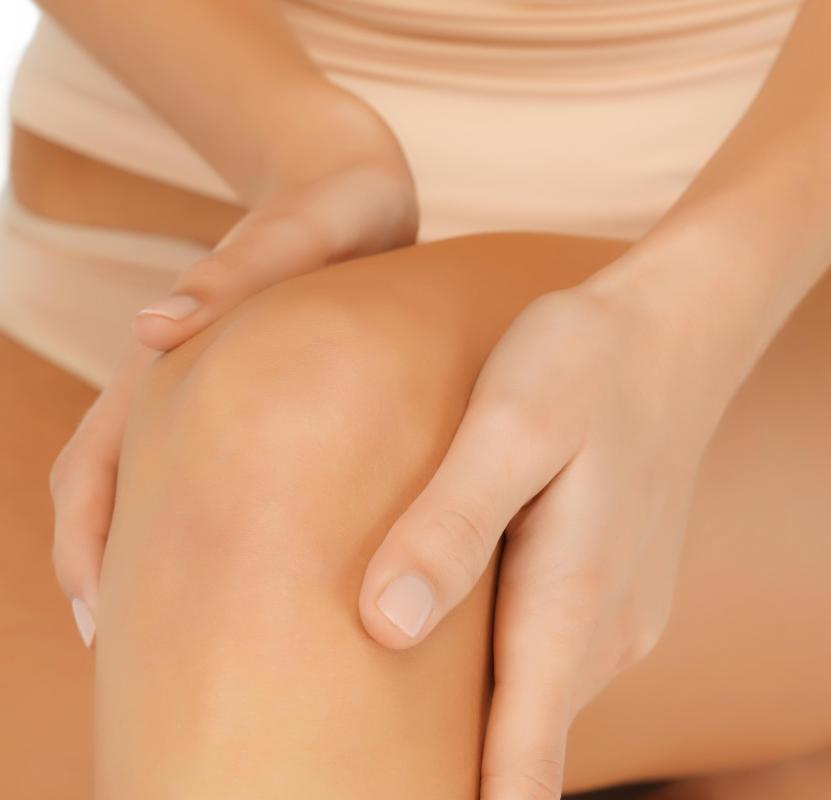At TheHealthBoard, we're committed to delivering accurate, trustworthy information. Our expert-authored content is rigorously fact-checked and sourced from credible authorities. Discover how we uphold the highest standards in providing you with reliable knowledge.
What are the Most Common Symptoms of a Knee Bone Spur?
Knee bone spurs, also known as osteophytes, may occur at the end of the thigh bone, shin bone, or knee cap in areas where the cartilage has worn away. Although the spur is not painful in and of itself, it may cause inflammation of the surrounding tissues or may contribute to the development of osteoarthritis. The symptoms caused by spurs may be treated with nonsteroidal anti-inflammatories, corticosteroids, or surgery.
The thin layer of cartilage that cushions the area where the bones meet in the knee may begin to break down. The cartilage may become frayed or develop pitting. When this happens, the bones try to compensate for the loss of cartilage by growing new bone tissue, or bone spurs. The ends of the bone thicken and the joint loses its shape. Bone spurs commonly occur in the knee, feet, hands, hips or spine.

Most of the time, the spurs do not hurt, but they may cause problems for nearby muscles, ligaments, tendons, nerves, or tissues. The area around the spur may become red and inflamed. People with knee bone spurs may also notice symptoms of osteoarthritis. Joints may lose range of motion, become more stiff than usual, or take on a deformed shape.
Other knee bone spur symptoms may include pain or a sensation of grating or catching when the knee is moved. A noticeable lump may be felt along the inside of the knee. Standing up from a seated position or walking up and down stairs may become more difficult for people with this condition. Over time, the muscles around the knee might become weak from lack of use. MRI, CT scans or X-rays of the knee will show cartilage degradation and bone spur development.

If the knee bone spur is not causing any pain or limiting ranging of motion, the doctor will probably not prescribe any treatment. On the other hand, if the patient is experiencing pain, swelling, or other symptoms, nonsteroidal anti-inflammatory drugs (NSAIDS) may be prescribed. These may include over-the-counter ibuprofen, aspirin, naproxen, or ketoprofen. If NSAIDS do not relieve the symptoms, a corticosteroid injection into the joint may be suggested.

Surgery is most often reserved as treatment for patients with knee bone spur symptoms that severely limit their day-to-day lives. The spur removal may be done arthroscopically. In this procedure, several small incisions are made around the knee. As the surgeon looks inside the knee with a small camera, the knee bone spur is removed with special tools. Once the bone spur is taken out, the symptoms should resolve.
AS FEATURED ON:
AS FEATURED ON:















Discussion Comments
Chronic knee pain is the main problem I have from my knee bone spur as well. It just hurts all the time and now I've also torn my meniscus because of the bone spur.
@burcidi-- I used to have the same issue, I could hear cracking and popping sounds from my knee. Your bone spur might have grown larger and the joints are having trouble adjusting to it. You need to see your doctor again.
Do you have pain? If you don't, you're lucky. I used to have so much pain that I couldn't sleep at night. I had steroids injected into my knee which relieved the pain. The relief is supposed to last at least a few years, but I have no idea what's going to happen after that. I might need a more serious knee bone spur treatment like surgery.
Can a bone spur cause cracking sounds when bending the knee?
I know I have a small knee bone spur, it was diagnosed several years ago but I didn't need treatment because it wasn't causing any trouble. Lately though, my knee is more stiff than usual. When I'm walking and bending my knee, I hear cracking sounds which is scaring me.
Do you think it's due to the bone spur?
Post your comments